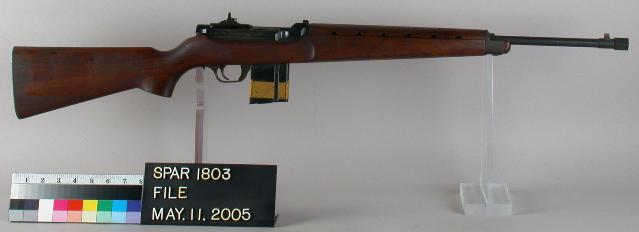Forgotten Weapons, an excellent website for the gun history buff, posted a copy of the manual for the Winchester Light Military Rifle back in 2011. The LMR (shown in the title image) is an obscure competitor to the early AR-15, against which it competed several times in the late 1950s. A relative of the highly successful M1 Carbine, the LMR was based on the Carbine’s immediate predecessor, the Williams Carbine, which itself had designed as an alternative to the M1 Carbine.

The .30 caliber Williams Carbine, upon which the LMR was based. David Marshal Williams designed this carbine based on his earlier rifle, the Winchester G30, as a parallel development to the Winchester carbine that would become the M1, which also used Williams’ now-famous tappet gas system. Image source, uscarbines.com.
The LMR was not unlike the later Ruger Mini-14 in design, though it differed in being far lighter (even lighter – at 4.9 pounds unloaded – than its cousin the M1 Carbine), and in being chambered for an oddball .22 caliber cartridge, the .224 caliber E2. This round had a very short, stubby 53 gr bullet fired at 3,300 ft/s muzzle velocity, but was otherwise compatible with .223 Remington (at the time .222 Remington Special) chambered weapons. For most tests before 1960, in fact, AR-15s were tested using the E2 cartridge for logistics reasons. It has been speculated that it was the short, easily stabilized bullet of the .224″ cartridge that masked the poor ability of the early AR-15’s 1-in-14″ twist barrel to stabilize the longer 55gr bullet of .223 ammunition in cold weather, until January of 1963, when the 1-in-12″ twist barrels were introduced.

The .224 E2 cartridge (right) next to an early “.222 Spl” marked cartridge (left; made as a special run of cartridges by Remington to allow the AR-15 to meet USAF penetration requirements at 500 yards, and functionally almost identical to the later .223 Remington commercial cartridge), and a Yugslavian copy of the 5.56mm M196 tracer (center). Image source, iaaforum.org.
The LMR was extensively tested, and found inferior to the AR-15 rifle in most respects. One such evaluation is the subject for today’s article; it was conducted in July of 1958 at Fort Benning, Georgia. Contained in the document are several interesting results, such as the Winchester LMR proving more accurate in semiautomatic and fully automatic fire both than the M14, but also somewhat less reliable and less resistant to the environment.
In the end, two major problems spelled the end of the Winchester rifle: In their mad rush for lighter weight, the Winchester engineers created a rifle that was fragile to handle (in particular, the handguard and trigger housing are cited as breaking with hard use), and the stubby bullet of the .224″ cartridge produced undesirable velocity loss over distance. The AR-15, which proved more reliable, less susceptible to parts breakage, and which possessed superior ballistics, continued in its development, eventually becoming the standard issue M16 rifle of the US Army.
 Your Privacy Choices
Your Privacy Choices
